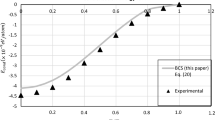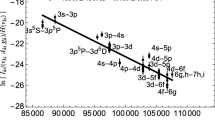Summary
The partial dynamical structure factors of a pure liquid metal are derived from the two-component theory developed in an earlier paper by March and Tosi. In particular, and in contrast to the usual procedure which assumes the hydrodynamic form for the ion-ion dynamical structureS ii(q, ω) to be the same as for a classical one-component liquid, in the present theory the contribution to the sound-wave attenuation from single-particle excitations in the conduction electron system is derived explicitly. It is suggested that this is closely related to the anomalous scaling with isotopic mass of the atomic transport coefficients in liquid lithium. The relation to neutron elastic scattering is also established, and some measurements on liquid gallium can be interpreted in a qualitative manner. By studying the charge-charge correlation function for the two-component liquid metal, a theory of electrical resistivity is afforded, which is shown to reduce to Baym’s treatment of the scattering of electrons by the density fluctuations in the limit of weak electron-ion interaction. The relation between the high-frequency conductivity, obtained for arbitrary strength of the electron-ion interaction and the classical Drude-Zener theory is pointed out, and the sum rules for conductivity are seen to be related to those forS ii(q, ω) in the limitq→0. A brief discussion of the thermodynamics of the two-component system is included, and related to results for weak electron-ion coupling.
Riassunto
Si derivano i fattori parziali di struttura dinamica per un metallo liquido puro dalla teoria a due componenti sviluppata in un lavoro precedente. In particolare, e a differenza dal solito trattamento che adotta la stessa forma idrodinamica per il fattore di struttura ione-ioneS ii(q, ω) come per un liquido classico ad un componente, si deriva esplicitamente il contributo all’attenuazione delle onde sonore dovuto ad eccitazioni elettrone-buca nel liquido di elettroni di conduzione. Si suggerisce che tale contributo è collegato alla dipendenza anomala dei coefficienti di trasporto atomico dalla massa isotopica nel litio liquido. Si stabilisce anche una relazione con la diffusione elastica di neutroni, interpretando qualitativamente alcune misure sul gallio liquido. Dallo studio della funzione di correlazione fra fluttuazioni di carica nel metallo liquido si deriva una teoria della resistività elettrica, che si riduce alla trattazione di Baym della diffusione di elettroni da fluttuazioni di densità nel limite di debole interazione elettrone-ione. La relazione fra la conducibilità ad alta frequenza per valori arbitrari dell’interazione elettrone-ione e la teoria classica di Drude-Zener vien sottolineata, e le regole di somma per la conducibilità si mostrano essere connesse a quelle perS ii(q, ω) nel limiteq→0. Si include pure una discussione della termodinamica del liquido a due componenti, che vien correlata a risultati validi per debole accoppiamento elettrone-ione.
Резюме
Выводятся парциальные факторы динамической структуры чистых жидких металлов, исходя из двухкомпонентнои теории, развитой ранее Марчем и Тоси. В противоположность обычной процедуре, в которой предполагается, что гидродинамическая форма для ион-ионной динамической структурыS ii(q, ω) является такой же, как для классической однокомпонентной жидкости, в настоящей теории вклад в затухание звуковой волны от одночастичных возбуждений в системе электронов проводомости выводится в явном виде. Предполагается, что это тесно связано с аномальным подобием по изотопической массе атомных транспортных коэффициенгов в жидком литии. Также устанавливается связь с упругим рассеянием нейтронов. Качественнум образом интерпретируются некоторые измерения в жидком галлии. Исследуя функцию заряд-зарядовой корреляции для двухкомпонентного жидкого металла, предлагается теория электрического сопротивления, которая сводится к рассмотрению Бейма рассеяния электронов на флуктуациях плотности в пределе слабого электрон-ионного взаимодействия. Определяется связь между проводимостью при высокой частоте, полученной для произвольной силы электрон-ионного взаимодействия, и классической теорией Друда-Зенера. Показывается, что правила сумм для проводимости связаны с правилами сумм дляS ii(q, ω) в пределеqр0. Проводится обсуждение термодинамики двухкомпонентной системы и результатов, полученных для слабой электрон-ионной связи.
Similar content being viewed by others
References
N. H. March andM. P. Tosi:Ann. of Phys.,81, 414 (1973).
M. Watabe andM. Hasegawa:II International Conference on Liquid Metals (London, 1973).
K. S. Singwi, A. Sjölander, M. P. Tosi andR. H. Land:Phys. Rev. B,1, 1044 (1970).
M. Parrinello andM. P. Tosi:Nuovo Cimento,12 B, 155 (1972).
G. Baym:Phys. Rev.,135, A 1691 (1964).
P. Vashishta andK. S. Singwi:Phys. Rev. B,6, 875 (1972).
B. Goodman andA. Sjölander:Phys. Rev. (to appear).
J. Hubbard andJ. L. Beeby:Proc. Phys. Soc.,2, 556 (1969).
K. S. Singwi, K. Sköld andM. P. Tosi:Phys. Rev. A,1, 454 (1970).
K. N. Pathak andK. S. Singwi:Phys. Rev. A,2, 2427 (1970).
H. Mori:Progr. Theor. Phys.,33, 423 (1965).
R. Kubo:Rep. Progr. Phys.,29, 265 (1966).
C. J. Pethick:Phys. Rev. B,2, 1789 (1970).
J. Chihara:II International Conference on Liquid Metals (London, 1973).
A. B. Pippard:Rep. Progr. Phys.,23, 176 (1960).
P. Vashishta, P. Bhattacharyya andK. S. Singwi:Phys. Rev. Lett.,30, 1248 (1973).
P. Gray:Journ. of Phys. F,3, L43 (1973).
H. Fröhlich:Physica,37, 215 (1967).
P. Ascarelli andR. J. Harrison:Phys. Rev. Lett.,22, 385 (1969).
M. P. Tosi andN. H. March:Nuovo Cimento,15 B, 308 (1973).
N. W. Aschcroft andD. C. Langreth:Phys. Rev.,155, 682 (1967).
R. T. Smith, G. M. B. Webber, F. R. Young andR. W. B. Stephens: inProperties of Liquid Metals, edited byP. D. Adams, H. H. Davies andS. G. Epstein (London, 1967), p. 515.
N. H. March andM. P. Tosi:Proc. Roy. Soc., A330, 373 (1972).
D. Pines andP. Nozières:The Theory of Quantum Liquids (New York, N. Y., 1966).
T. C. Faber:An Introduction to the Theory of Liquid Metals (Cambridge, 1972).
H. Hinkelmann:Phys. Lett.,33 A, 479 (1970).
J. Jones:Journ. of Phys. F,3, 1577 (1973).
P. D. Randolph:Phys. Rev.,134, A 1238 (1964).
M. I. Barker, N. H. March, M. Johnson andD. I. Page:II International Conference on Liquid Metals (London, 1973).
N. T. Ban, C. M. Randall andD. J. Montgomery:Phys. Rev.,128, 6 (1960).
R. C. Brown andN. H. March:Phys. Chem. Liq.,1, 129 (1968).
M. H. Ernst, E. H. Hauge andJ. M. J. Van Leeuwen:Phys. Rev. Lett.,25, 1254 (1970).
T. Gaskell andN. H. March:Phys. Lett.,33 A, 460 (1970).
A. Paskin: inProperties of Liquid Metals, edited byP. D. Adams, H. H. Davies andS. G. Epstein (London, 1967), p. 223.
J. L. Beeby:Proc. Roy. Soc., A302, 113 (1967).
M. J. Lighthill:Fourier Analysis and Generalized Functions (Cambridge, 1964).
L. P. Kadanoff andG. Baym:Quantum Statistical Mechanics (New York, N. Y., 1962).
Author information
Authors and Affiliations
Additional information
Work largely carried out at the International Center for Theoretical Physics of the I.A.E.A.
Переведено редакцией.
Rights and permissions
About this article
Cite this article
Tosi, M.P., Parrinello, M. & March, N.H. Electronic effects in dynamical structure of liquid metals. Nuov Cim B 23, 135–171 (1974). https://doi.org/10.1007/BF02737503
Received:
Published:
Issue Date:
DOI: https://doi.org/10.1007/BF02737503




